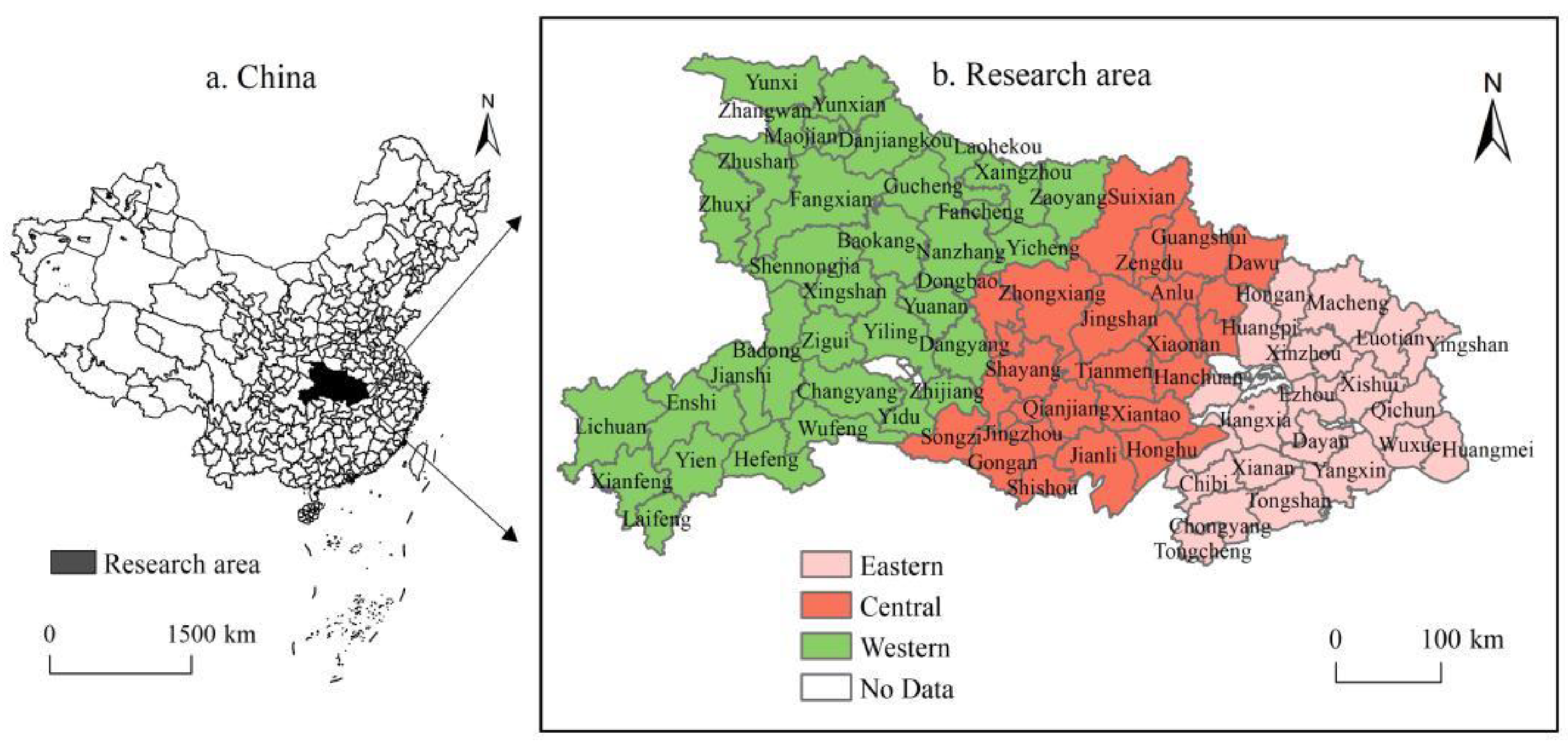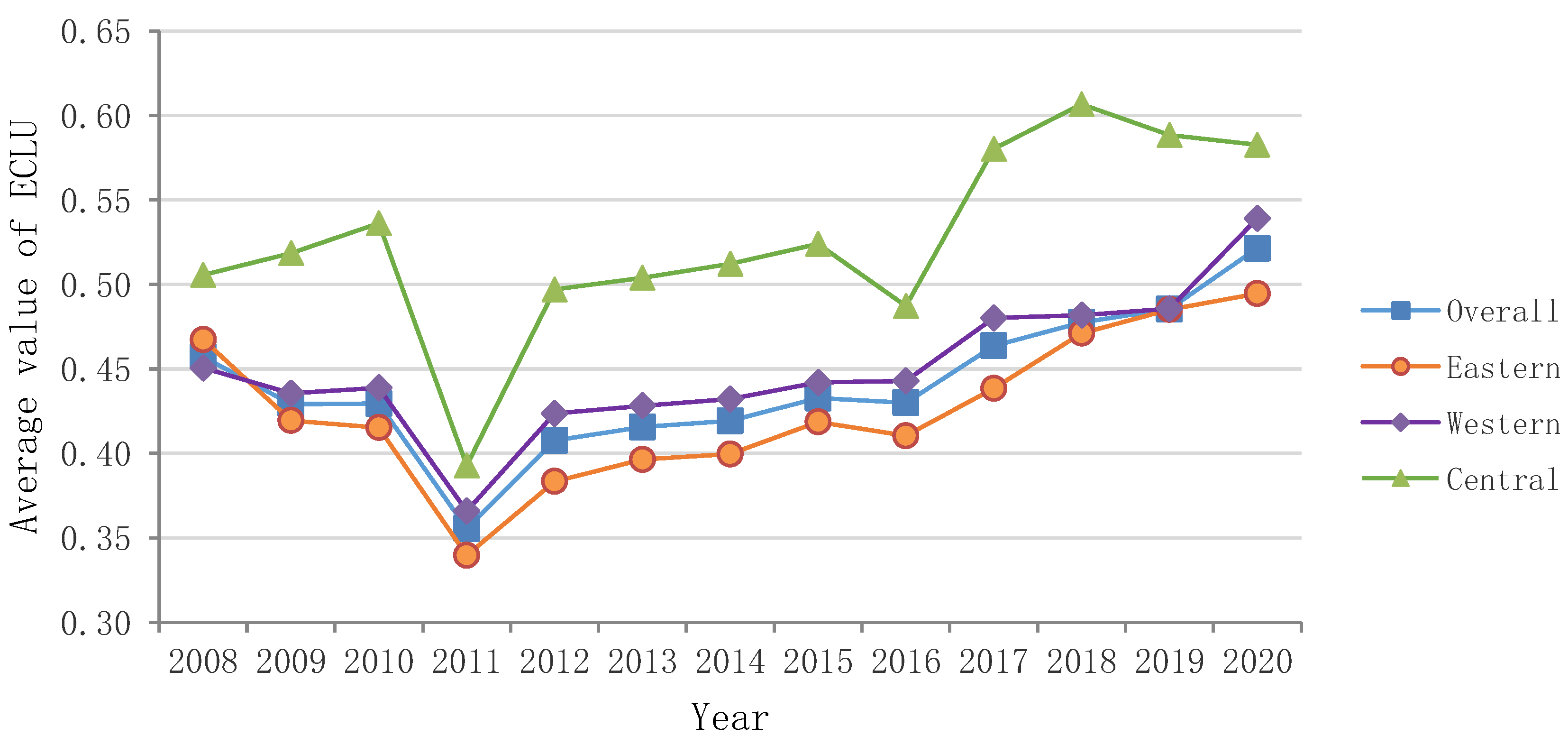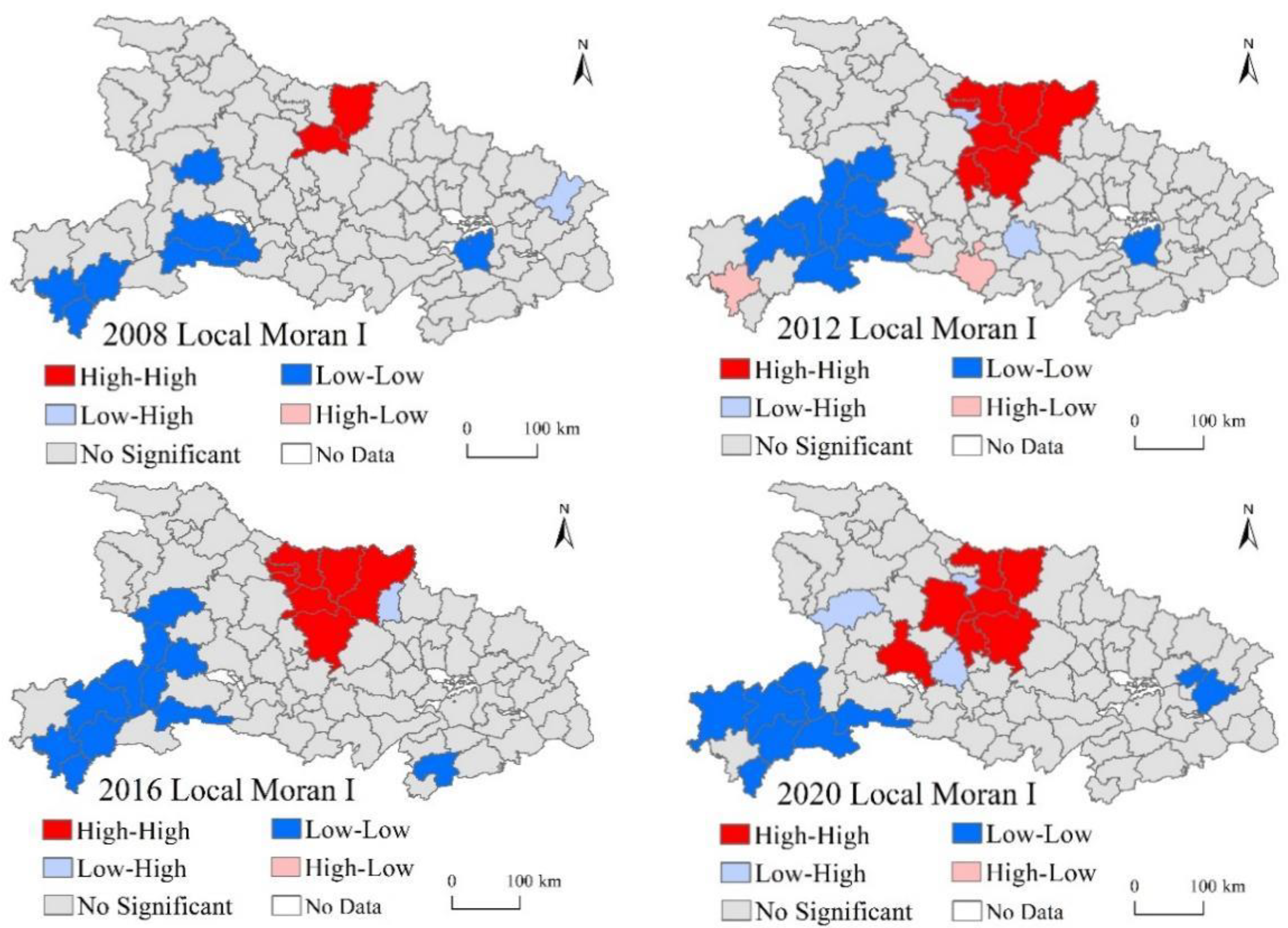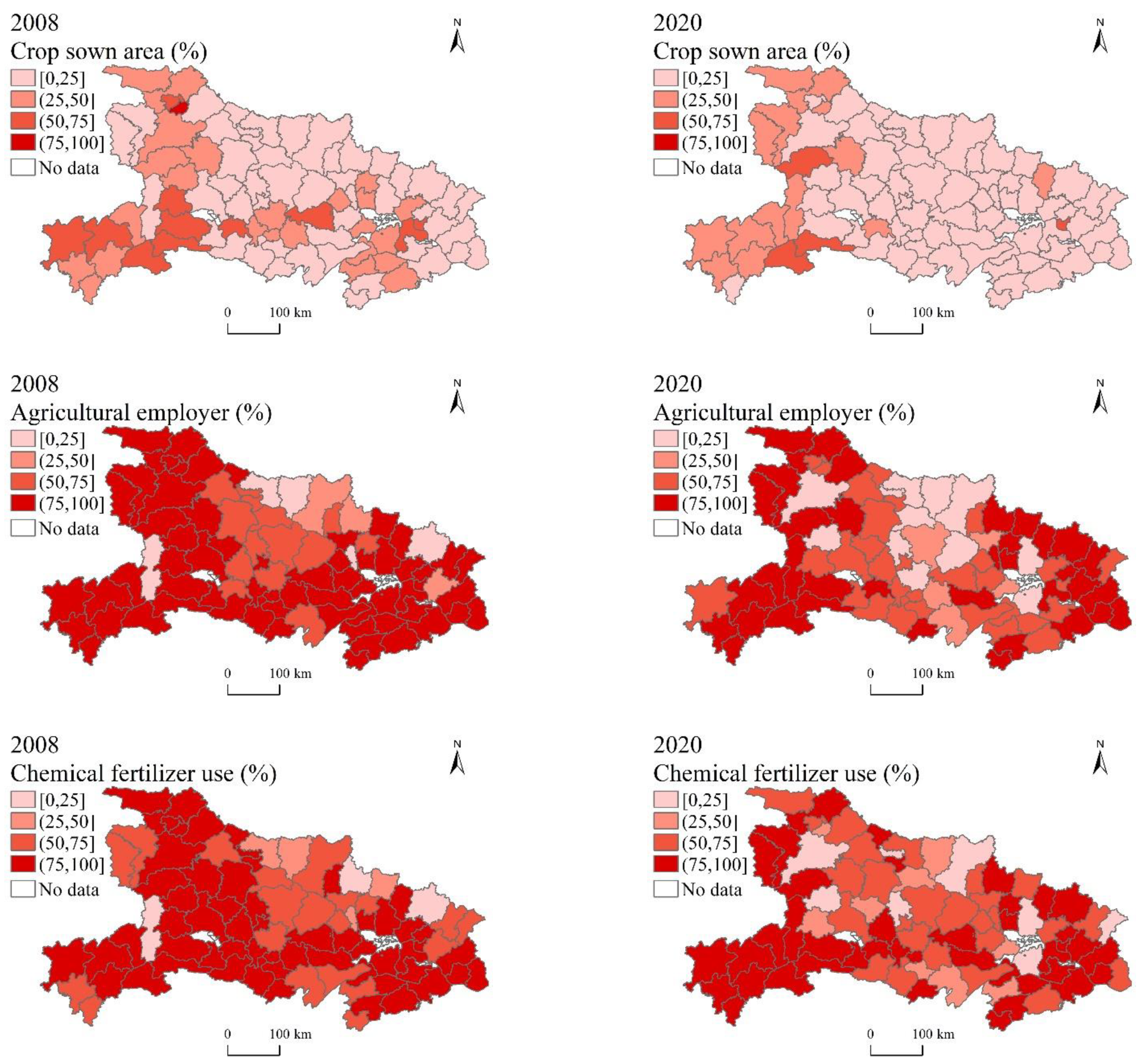Spatial Distribution Evolution and Optimization Path of Eco-Efficiency of Cultivated Land Use: A Case Study of Hubei Province, China
Abstract
:1. Introduction
2. Materials and Methods
2.1. Research Area
2.2. Research Methods
2.2.1. The Undesired Super-Efficiency SBM Model
2.2.2. Exploring Space Date Analysis
2.3. Data Sources
2.4. Evaluation Index System of ECLU
3. Results and Analysis
3.1. Time Series Characteristic Analysis of ECLU
3.2. Spatial Characteristic Analysis of ECLU
3.2.1. Analysis of the Global Spatial Characteristics of ECLU
3.2.2. Analysis of the Local Spatial Characteristics of ECLU
- (1)
- In 2008, ECLU was a high–high agglomeration area that mainly showed a spatial pattern of “single-core agglomeration”, covering two cities, Zaoyang and Yicheng, both of which are the largest grain-producing counties in China. ECLU was a low–low agglomeration area that mainly presents a spatial pattern of “multi-core agglomeration”, composed of eight cities distributed in the southern, southeastern, and central parts of the mountainous areas of Western.
- (2)
- In 2012, ECLU was a high–high agglomeration area that mainly showed the trend of “single core expansion”. The core continued to radiate outwards on the basis of the agglomeration pattern in 2008, mainly covering seven cities, including the central and eastern part of Xiangyang, most of Suizhou, and the central and western parts of Jingmen. ECLU was a low–low agglomeration area that mainly presents a spatial pattern of “single-core agglomeration”. The core is mainly based on the clustering pattern in 2008, which is composed of three single cores that converge into one single core, covering nine cities, including Enshi, where they are still distributed in the central and southern mountainous areas of Western.
- (3)
- In 2016, ECLU was a high–high agglomeration area that was still dominated by the spatial pattern of “single-core agglomeration”, which was roughly similar to the agglomeration pattern in 2012. The spatial pattern of the low ECLU agglomeration area still maintains “single core agglomeration”, but the distribution range extends from the central and southern parts of the Western mountain area to the southwest–northeast direction, and the coverage increases to 10 cities.
- (4)
- In 2020, ECLU was a high–high agglomeration area that mainly showed the spatial pattern of “single-core agglomeration” and point-like distribution, and the main change trend migrated to the central and western plains on the basis of the agglomeration pattern in 2016. ECLU was a low–low agglomeration area that continued to migrate to the southwest of Hubei, mainly in ethnic minority areas, such as Enshi. These areas account for a large proportion of mountainous and hilly landforms, and the fragmentation of cultivated land is more serious.
3.3. Analysis of the Redundancy Status of ECLU
4. Discussion
5. Conclusions
6. Policy Implication
7. Insufficient
Author Contributions
Funding
Institutional Review Board Statement
Informed Consent Statement
Data Availability Statement
Conflicts of Interest
References
- Xiuhua, S.; Fei, Z.; Zhe, W. Research on optimization of ecological service function and planning control of land resources planning based on ecological protection and restoration. Environ. Technol. Innov. 2021, 24, 101904. [Google Scholar] [CrossRef]
- Zhang, C.; Su, Y.; Yang, G.; Chen, D.; Yang, R. Spatial-Temporal Characteristics of Cultivated Land Use Efficiency in Major Function-Oriented Zones: A Case Study of Zhejiang Province, China. Land 2020, 9, 114. [Google Scholar] [CrossRef]
- Liu, Z.; Gu, H.; Liang, A.; Li, L.; Yao, Q.; Xu, Y.; Liu, J.; Jin, J.; Liu, X.; Wang, G. Conservation Tillage Regulates the Assembly, Network Structure and Ecological Function of the Soil Bacterial Community in Black Soils. Plant Soil 2022, 472, 207–223. [Google Scholar] [CrossRef]
- Wang, X. Changes in Cultivated Land Loss and Landscape Fragmentation in China from 2000 to 2020. Land 2022, 11, 684. [Google Scholar] [CrossRef]
- Christian, S.; Daniela, B.; Elisabeth, A.; David, W.T.K.; Sebastian, G.; Thilo, S.; Enno, B. Integrated Assessment of Regional Approaches for Biodiversity Offsetting in Urban-Rural Areas—A Future Based Case Study from Germany Using Arable Land as An Example. Land Use Policy 2022, 117, 106085. [Google Scholar] [CrossRef]
- Bigelow, D.P.; Lewis, D.J.; Mihiar, C. A Major Shift in US Land Development Avoids Significant Losses in Forest and Agricultural Land. Environ. Res. Lett. 2022, 17, 024007. [Google Scholar] [CrossRef]
- You, H.; Wu, C. Analysis of Carbon Emission Efficiency and Optimization of Low Carbon for Agricultural Land Intensive Use. Trans. Chin. Soc. Agric. Eng. 2014, 30, 224–234. [Google Scholar]
- Jiang, S.; Zhou, J.; Qiu, S. Can Appropriate Scale Operation Restrain Agricultural Non-Point Source Pollution?—Empirical Study Based on Dynamic Threshold Panel Model. J. Agrotech. Economics. 2021, 7, 33–48. [Google Scholar]
- Deng, X.; Gibson, J. Sustainable Land Use Management for Improving Land Eco-Efficiency: A Case Study of Hebei, China. Ann. Oper. Res. 2020, 290, 265–277. [Google Scholar] [CrossRef]
- Fan, Z.; Deng, C.; Fan, Y.; Zhang, P.; Lu, H. Spatial-Temporal Pattern and Evolution Trend of the Cultivated Land Use Eco-Efficiency in the National Pilot Zone for Ecological Conservation in China. Int. J. Environ. Res. Public Health 2021, 19, 111. [Google Scholar] [CrossRef]
- Hou, X.; Liu, J.; Zhang, D.; Zhao, M.; Xia, C. Impact of Urbanization on the Eco-Efficiency of Cultivated Land Utilization: A Case Study on the Yangtze River Economic Belt, China. J. Clean. Prod. 2019, 238, 117916. [Google Scholar] [CrossRef]
- Ke, N.; Zhang, X.; Lu, X.; Kuang, B.; Jiang, B. Regional Disparities and Influencing Factors of Eco-Efficiency of Arable Land Utilization in China. Land 2022, 11, 257. [Google Scholar] [CrossRef]
- Zou, X.Q.; Xie, M.H.; Li, Z.Y.; Duan, K.F. Spatial Spillover Effect of Rural Labor Transfer on the Eco-Efficiency of Cultivated Land Use: Evidence from China. Int. J. Environ. Res. Public Health 2022, 19, 9660. [Google Scholar] [CrossRef] [PubMed]
- Brown, L.R. Who Will Feed China?: Wake-Up Call for a Small Planet; WW Norton & Company: New York, NY, USA, 1995. [Google Scholar]
- Liu, M.B.; Zhang, A.L.; Wen, G.H. Temporal and Spatial Pattern and Evolution Trend of Cultivated Land Use Ecological Efficiency in the Main Grain Producing Areas in the Lower Yangtze Region. China Land Sci. 2021, 35, 50–60. [Google Scholar]
- Wen, G.H.; Liu, M.B.; Hu, X.H.; Zhao, J. Spatial Correlation and Spatial Effect of Cultivated Land Use Ecological Efficiency in the Dongting Lake Plain. Sci. Geogr. Sin. 2022, 6, 1–11. [Google Scholar]
- Yang, B.; Chen, X.; Wang, Z.; Li, W.; Zhang, C.; Yao, X. Analyzing Land Use Structure Efficiency with Carbon Emissions: A Case Study in the Middle Reaches of the Yangtze River, China. J. Clean. Prod. 2020, 274, 123076. [Google Scholar] [CrossRef]
- Pearson, D.; Gorman, J.; Aspinall, R. Multiple Roles for Landscape Ecology in Future Farming Systems: An Editorial Overview. Land 2022, 11, 288. [Google Scholar] [CrossRef]
- Iancu, D.A.; Trichakis, N. Pareto Efficiency in Robust Optimization. Manag. Sci. 2014, 60, 130–147. [Google Scholar] [CrossRef]
- Schaltegger, S.; Sturm, A. Ökologische Rationalität: Ansatzpunkte Zur Ausgestaltung von Ökologieorientierten Managementinstrumenten. Die Unternehm. 1990, 44, 273–290. [Google Scholar]
- Yin, Y.; Hou, X.; Liu, J.; Zhou, X.; Zhang, D. Detection and Attribution of Changes in Cultivated Land Use Ecological Efficiency: A Case Study on Yangtze River Economic Belt, China. Ecol. Indic. 2022, 137, 108753. [Google Scholar] [CrossRef]
- Zhao, Z.; Bai, Y.; Wang, G.; Chen, J.; Yu, J.; Liu, W. Land Eco-Efficiency for New-Type Urbanization in the Beijing-Tianjin-Hebei Region. Technol. Forecast. Soc. Chang. 2018, 137, 19–26. [Google Scholar] [CrossRef]
- Liu, M.-B.; Zhang, A.-L.; Wen, G.-H. Regional Differences and Spatial Convergence in the Ecological Efficiency of Cultivated Land Use in the Main Grain Producing Areas in the Yangtze Region. J. Nat. Resour. 2022, 37, 477–493. [Google Scholar] [CrossRef]
- Lyu, X.; Peng, W.; Niu, S.; Qu, Y.; Xin, Z. Evaluation of Sustainable Intensification of Cultivated Land Use According to Farming Households’ Livelihood Types. Ecol. Indic. 2022, 138, 108848. [Google Scholar] [CrossRef]
- Lu, X.; Hou, J.; Tang, Y.; Wang, T.; Li, T.; Zhang, X. Evaluating the Impact of the Highway Infrastructure Construction and the Threshold Effect on Cultivated Land Use Efficiency: Evidence from Chinese Provincial Panel Data. Land 2022, 11, 1044. [Google Scholar] [CrossRef]
- Han, H.; Zhang, X. Static and Dynamic Cultivated Land Use Efficiency in China: A Minimum Distance to Strong Efficient Frontier Approach. J. Clean. Prod. 2020, 246, 119002. [Google Scholar] [CrossRef]
- Li, Y.; Li, Y.; Westlund, H.; Liu, Y. Urban–Rural Transformation in Relation to Cultivated Land Conversion in China: Implications for Optimizing Land Use and Balanced Regional Development. Land Use Policy 2015, 47, 218–224. [Google Scholar] [CrossRef]
- Kuang, B.; Lu, X.; Zhou, M.; Chen, D. Provincial Cultivated Land Use Efficiency in China: Empirical Analysis Based on the SBM-DEA Model with Carbon Emissions Considered. Technol. Forecast. Soc. Chang. 2019, 151, 119874. [Google Scholar] [CrossRef]
- Lai, Z.; Chen, M.; Liu, T. Changes in and Prospects for Cultivated Land Use Since the Reform and Opening Up in China. Land Use Policy 2020, 97, 104781. [Google Scholar] [CrossRef]
- Xiao, P.; Xu, J.; Yu, Z.; Qian, P.; Lu, M.; Ma, C. Spatiotemporal Pattern Differentiation and Influencing Factors of Cultivated Land Use Efficiency in Hubei Province under Carbon Emission Constraints. Sustainability 2022, 14, 7042. [Google Scholar] [CrossRef]
- Lu, X.; Zhang, Y.; Li, J.; Duan, K. Measuring the Urban Land Use Efficiency of Three Urban Agglomerations in China Under Carbon Emissions. Environ. Sci. Pollut. Res. 2022, 29, 36443–36474. [Google Scholar] [CrossRef]
- Arshad, M.; Amjath-Babu, T.; Aravindakshan, S.; Krupnik, T.J.; Toussaint, V.; Kächele, H.; Müller, K. Climatic Variability and Thermal Stress in Pakistan’s Rice and Wheat Systems: A Stochastic Frontier and Quantile Regression Analysis of Economic Efficiency. Ecol. Indic. 2018, 89, 496–506. [Google Scholar] [CrossRef]
- Zhang, Q.; Sun, Z.; Huang, W. Does Land Perform Well for Corn Planting? An Empirical Study on Land Use Efficiency in China. Land Use Policy 2018, 74, 273–280. [Google Scholar] [CrossRef]
- Mango, N.; Makate, C.; Hanyani-Mlambo, B.; Siziba, S.; Lundy, M. A Stochastic Frontier Analysis of Technical Efficiency in Smallholder Maize Production in Zimbabwe: The Post-Fast-Track Land Reform Outlook. Cogent Econ. Finance 2015, 3, 1117189. [Google Scholar] [CrossRef]
- Biswajit, G.; Namita, C. Application of the Ecological Footprint Method for Measuring Sustainability of Agricultural Land use at a Micro Level in Barddhaman District, West Bengal, India. Current Science 2018, 115, 1913–1920. [Google Scholar]
- Yan, J.; Wang, M.; Su, F.; Zhang, X.; Gao, S.; Xu, M. Changes in Land Cover and Ecological Stress in Borneo Based on Remote Sensing and an Ecological Footprint Method. Landsc. Ecol. Eng. 2020, 16, 319–333. [Google Scholar] [CrossRef]
- Yu, X.; Geng, Y.; Dong, H.; Fujita, T.; Liu, Z. Emergy-Based Sustainability Assessment on Natural Resource Utilization In 30 Chinese Provinces. J. Clean. Prod. 2016, 133, 18–27. [Google Scholar] [CrossRef]
- Rashidi, K.; Saen, R.F. Incorporating Dynamic Concept into Gradual Efficiency: Improving Suppliers in Sustainable Supplier Development. J. Clean. Prod. 2018, 202, 226–243. [Google Scholar] [CrossRef]
- Skevas, T.; Stefanou, S.E.; Lansink, A.O. Pesticide Use, Environmental Spillovers and Efficiency: A DEA Risk-Adjusted Efficiency Approach Applied to Dutch Arable Farming. Eur. J. Oper. Res. 2014, 237, 658–664. [Google Scholar] [CrossRef]
- Mwambo, F.M.; Fürst, C.; Nyarko, B.K.; Borgemeister, C.; Martius, C. Maize Production and Environmental Costs: Resource Evaluation and Strategic Land Use Planning for Food Security in Northern Ghana by Means of Coupled Emergy and Data Envelopment Analysis. Land Use Policy 2020, 95, 104490. [Google Scholar] [CrossRef]
- Liu, W.; Zhan, J.; Zhao, F.; Wang, P.; Li, Z.; Teng, Y. Changing Trends and Influencing Factors of Energy Productivity Growth: A Case Study in the Pearl River Delta Metropolitan Region. Technol. Forecast. Soc. Chang. 2018, 137, 1–9. [Google Scholar] [CrossRef]
- Liu, W.; Zhan, J.; Wang, C.; Li, S.; Zhang, F. Environmentally Sensitive Productivity Growth of Industrial Sectors in the Pearl River Delta. Resour. Conserv. Recycl. 2018, 139, 50–63. [Google Scholar] [CrossRef]
- Moutinho, V.; Madaleno, M.; Macedo, P. The Effect of Urban Air Pollutants in Germany: Eco-Efficiency Analysis Through Fractional Regression Models Applied After DEA and SFA Efficiency Predictions. Sustain. Cities Soc. 2020, 59, 102204. [Google Scholar] [CrossRef]
- Yongjun, L.; Jing, Q.; Lei, X.; Lingyan, H.; Yue, S.; Mengmeng, Z.; Ke, W.; Jing, Z.; Shan, H.; Lu, H. Assessing economic sustainability and ecological efficiency with genuine progress indicator: A case study of the Yangtze River Delta from 2000 to 2018. Environ. Sci. Pollut. Res. Int. 2022, 29, 46751–46766. [Google Scholar] [CrossRef]
- Merlin, G.; Boileau, H. Eco-Efficiency and Entropy Generation Evaluation Based on Emergy Analysis: Application to Two Small Biogas Plants. J. Clean. Prod. 2017, 143, 257–268. [Google Scholar] [CrossRef]
- Yang, B.; Wang, Z.; Zou, L.; Zou, L.; Zhang, H. Exploring the Eco-Efficiency of Cultivated Land Utilization and Its Influencing Factors in China's Yangtze River Economic Belt, 2001–2018. J. Environ. Manag. 2021, 294, 112939. [Google Scholar] [CrossRef]
- Liu, Y.; Zou, L.; Wang, Y. Spatial-Temporal Characteristics and Influencing Factors of Agricultural Eco-Efficiency in China in Recent 40 Years. Land Use Policy 2020, 97, 104794. [Google Scholar] [CrossRef]
- Wei, C.; Wen, Z.; Tao, W.; Xiaochun, W.; Jinhai, X. Spatial-Temporal Characteristics of Cultivated Land Use Eco-Efficiency Under Carbon Constraints and Its Relationship with Landscape Pattern Dynamics. Ecol. Indic. 2022, 141, 109140. [Google Scholar] [CrossRef]
- Ma, L.Y.; Zhang, R.H.; Pan, Z.C.; Wei, F. Analysis of the Evolution and Influencing Factors of Temporal and Spatial Pattern of Eco-Efficiency of Cultivated Land Use Among Provinces in China: Based on Panel Data from 2000 to 2019. China Land Sci. 2022, 36, 74–85. [Google Scholar]
- Xie, H.; Chen, Q.; Wang, W.; He, Y. Analyzing the Green Efficiency of Arable Land Use in China. Technol. Forecast. Soc. Chang. 2018, 133, 15–28. [Google Scholar] [CrossRef]
- Yumeng, W.; Jiaxu, L.; Xiangzhi, K. What Drives Land Abandonment in Core Grain-Producing Areas? Evidence from China. Int. J. Environ. Res. Public Health 2022, 19, 5090. [Google Scholar] [CrossRef]
- Zifeng, Y.; Liang, Z.; Dongqi, S.; Fengning, H. Impacts of Urban Expansion on the Loss and Fragmentation of Cropland in the Major Grain Production Areas of China. Land 2022, 11, 130. [Google Scholar] [CrossRef]
- Luo, X.; Ao, X.; Zhang, Z.; Wan, Q.; Liu, X. Spatiotemporal Variations of Cultivated Land Use Efficiency in the Yangtze River Economic Belt Based on Carbon Emission Constraints. J. Geogr. Sci. 2020, 30, 535–552. [Google Scholar] [CrossRef]
- Tone, K. A slacks-Based Measure of Efficiency in Data Envelopment Analysis. Eur. J. Oper. Res. 2001, 130, 498–509. [Google Scholar] [CrossRef]
- Tone, K. Data Envelopment Analysis as a Kaizen Tool: SBM Variations Revisited. Bull. Math. Sci. Appl. 2016, 16, 49. [Google Scholar] [CrossRef]
- Chen, M.; Chen, H. Spatiotemporal Coupling Measurement of Industrial Wastewater Discharge and Industrial Economy in China. Environ. Sci. Pollut. Res. 2021, 28, 46319–46333. [Google Scholar] [CrossRef]
- West, T.O.; Marland, G. A Synthesis of Carbon Sequestration, Carbon Emissions, and Net Carbon Flux in Agriculture: Comparing Tillage Practices in the United States. Agric. Ecosyst. Environ. 2002, 91, 217–232. [Google Scholar] [CrossRef]
- Li, B.; Zhang, J.B.; Li, H.P. Research on Spatial-Temporal Characteristics and Affecting Factors Decomposition of Agricultural Carbon Emission in China. China Popul. Resour. Environ. 2011, 21, 80–86. [Google Scholar] [CrossRef]
- Zhang, Z.; Xu, E.; Zhang, H. Complex Network and Redundancy Analysis of Spatial–Temporal Dynamic Changes and Driving Forces Behind Changes in Oases Within the Tarim Basin in Northwestern China. CATENA 2021, 201, 105216. [Google Scholar] [CrossRef]
- Fader, M.; Rulli, M.C.; Carr, J.; Dell’Angelo, J.; D’Odorico, P.; Gephart, J.A.; Kummu, M.; Magliocca, N.; Porkka, M.; Prell, C.; et al. Past and Present Biophysical Redundancy of Countries as a Buffer to Changes in Food Supply. Environ. Res. Lett. 2016, 11, 55008. [Google Scholar] [CrossRef]
- Yan, D.; Zheng, S.F. The Influence of Information Ability on Farmers’ Ecological Farming Adoption Behavior: Mediation Effect Based on Ecological Cognition and Adjustment Effect of Agricultural Income Share. China Land Sci. 2020, 34, 76–84. [Google Scholar]
- Tang, Y.; Lu, X.; Yi, J.; Wang, H.; Zhang, X.; Zheng, W. Evaluating the Spatial Spillover Effect of Farmland Use Transition on Grain Production—An Empirical Study in Hubei Province, China. Ecol. Indic. 2021, 125, 107478. [Google Scholar] [CrossRef]
- Xin, Y.; Yuejian, W.; Na, L.; Hailiang, X.; Zili, F. Assessment of Value Changes and Spatial Differences in Land Use Based on an Empirical Survey in the Manas River Basin. Land 2021, 10, 961. [Google Scholar] [CrossRef]
- Zhao, Y.; Jiang, Q.; Wang, Z. The System Evaluation of Grain Production Efficiency and Analysis of Driving Factors in Heilongjiang Province. Water 2019, 11, 1073. [Google Scholar] [CrossRef]
- He, G.; Zhang, Z.; Zhang, J.; Huang, X. Soil Organic Carbon Dynamics and Driving Factors in Typical Cultivated Land on the Karst Plateau. Int. J. Environ. Res. Public Health 2020, 17, 5697. [Google Scholar] [CrossRef] [PubMed]
- Won, K.G.; Yeon, L.J.; Saiful, I.B.M.; Suvendu, D.; Israr, K.M.; Joo, K.P. Investigating the Arable Land That Is the Main Contributor to Global Warming Between Paddy and Upland Vegetable Crops Under Excessive Nitrogen Fertilization. J. Clean. Prod. 2022, 346, 131197. [Google Scholar] [CrossRef]





| Variable Type | Variable Name | Unit | References |
|---|---|---|---|
| Input | Crop sown area(CSA) | 103 hectares | Ke et al. [12] |
| Agricultural employer(AE) | 104 people | Lu et al. [25] | |
| Chemical fertilizer use(CFU) | 104 t | Fan et al. [10] | |
| Agricultural machinery power(AMP) | 104 kW·h | Kuang et al. [28] | |
| Desired output | Total value of agricultural output | 104 Yuan | Wen et al. [16] |
| Grain total output | 104 t | Ma et al. [49] | |
| Undesired output | Carbon emission | 104 t | Liu et al. [23] |
| Pollution emissions | 104 t | West et al. [57] |
| Year | Moran’s I | SD | Z-Value | p-Value |
|---|---|---|---|---|
| 2008 | 0.122 | 0.075 | 1.772 | 0.054 |
| 2012 | 0.320 | 0.075 | 4.405 | 0.001 |
| 2016 | 0.317 | 0.075 | 4.426 | 0.001 |
| 2020 | 0.251 | 0.077 | 3.447 | 0.001 |
| Year | Region | CSA (%) | AM (%) | CFU (%) | AMP (%) | ECLU |
|---|---|---|---|---|---|---|
| 2008 | Eastern | 19.35 | 75.31 | 77.84 | 54.15 | 0.467 |
| Central | 18.21 | 85.06 | 84.23 | 64.22 | 0.506 | |
| Western | 21.18 | 88.17 | 86.73 | 68.80 | 0.451 | |
| Overall | 21.21 | 89.17 | 86.93 | 70.86 | 0.457 | |
| 2012 | Eastern | 19.88 | 73.33 | 80.12 | 65.41 | 0.383 |
| Central | 18.74 | 78.50 | 83.54 | 72.80 | 0.497 | |
| Western | 20.97 | 80.16 | 84.45 | 73.92 | 0.424 | |
| Overall | 21.04 | 82.15 | 85.25 | 75.67 | 0.408 | |
| 2016 | Eastern | 16.30 | 70.71 | 77.43 | 65.05 | 0.410 |
| Central | 18.88 | 75.34 | 80.01 | 69.55 | 0.490 | |
| Western | 19.39 | 72.26 | 78.84 | 66.69 | 0.440 | |
| Overall | 18.36 | 71.64 | 77.74 | 65.89 | 0.430 | |
| 2020 | Eastern | 9.80 | 61.65 | 63.21 | 62.45 | 0.495 |
| Central | 12.22 | 67.62 | 70.08 | 64.72 | 0.583 | |
| Western | 13.55 | 65.26 | 67.27 | 65.21 | 0.539 | |
| Overall | 12.30 | 63.60 | 65.45 | 64.01 | 0.521 |
Publisher’s Note: MDPI stays neutral with regard to jurisdictional claims in published maps and institutional affiliations. |
© 2022 by the authors. Licensee MDPI, Basel, Switzerland. This article is an open access article distributed under the terms and conditions of the Creative Commons Attribution (CC BY) license (https://creativecommons.org/licenses/by/4.0/).
Share and Cite
Wu, Y.; Zhang, P.; Li, J.; Hou, J. Spatial Distribution Evolution and Optimization Path of Eco-Efficiency of Cultivated Land Use: A Case Study of Hubei Province, China. Sustainability 2022, 14, 11417. https://doi.org/10.3390/su141811417
Wu Y, Zhang P, Li J, Hou J. Spatial Distribution Evolution and Optimization Path of Eco-Efficiency of Cultivated Land Use: A Case Study of Hubei Province, China. Sustainability. 2022; 14(18):11417. https://doi.org/10.3390/su141811417
Chicago/Turabian StyleWu, Yuling, Pei Zhang, Jia Li, and Jiao Hou. 2022. "Spatial Distribution Evolution and Optimization Path of Eco-Efficiency of Cultivated Land Use: A Case Study of Hubei Province, China" Sustainability 14, no. 18: 11417. https://doi.org/10.3390/su141811417
APA StyleWu, Y., Zhang, P., Li, J., & Hou, J. (2022). Spatial Distribution Evolution and Optimization Path of Eco-Efficiency of Cultivated Land Use: A Case Study of Hubei Province, China. Sustainability, 14(18), 11417. https://doi.org/10.3390/su141811417






